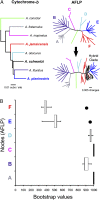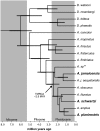Natural hybridization generates mammalian lineage with species characteristics
- PMID: 20534512
- PMCID: PMC2895066
- DOI: 10.1073/pnas.1000133107
Natural hybridization generates mammalian lineage with species characteristics
Abstract
Most diploid species arise from single-species ancestors. Hybrid origins of new species are uncommon (except among polyploids) and are documented infrequently in animals. Examples of natural hybridization leading to speciation in mammals are exceedingly rare. Here, we show a Caribbean species of bat (Artibeus schwartzi) has a nuclear genome derived from two nonsister but congeneric species (A. jamaicensis and A. planirostris) and a mitochondrial genome that is from a third extinct or uncharacterized congener. Artibeus schwartzi is self-sustaining, morphologically distinct, and exists in near geographic isolation of its known parent species. Island effects (i.e., area, reduced habitat variability, and geographic isolation) likely have restricted gene flow from parental species into the Caribbean populations of this hybrid lineage, thus contributing to local adaptation and isolation of this newly produced taxon. We hypothesize differential rates of the development of reproductive isolation within the genus and estimate that 2.5 million years was an insufficient amount of time for the development of postzygotic isolation among the three species that hybridized to produce A. schwartzi. Reticulated evolution thus has resulted in a genomic combination from three evolutionary lineages and a transgressive phenotype that is distinct from all other known species of Artibeus. The data herein further demonstrate the phenomenon of speciation by hybridization in mammals is possible in nature.
Conflict of interest statement
The authors declare no conflict of interest.
Figures




References
-
- Mavárez J, et al. Speciation by hybridization in Heliconius butterflies. Nature. 2006;441:868–871. - PubMed
-
- Gompert Z, Fordyce JA, Forister ML, Shapiro AM, Nice CC. Homoploid hybrid speciation in an extreme habitat. Science. 2006;314:1923–1925. - PubMed
-
- Schwarz D, Matta BM, Shakir-Botteri NL, McPheron BA. Host shift to an invasive plant triggers rapid animal hybrid speciation. Nature. 2005;436:546–549. - PubMed
-
- Helms Cahan S, Keller L. Complex hybrid origin of genetic caste determination in harvester ants. Nature. 2003;424:306–309. - PubMed
Publication types
MeSH terms
Substances
Associated data
- Actions
- Actions
- Actions
- Actions
- Actions
- Actions
- Actions
- Actions
- Actions
- Actions
- Actions
- Actions
- Actions
- Actions
- Actions
- Actions
- Actions
- Actions
- Actions
- Actions
- Actions
- Actions
- Actions
- Actions
- Actions
- Actions
- Actions
- Actions
- Actions
- Actions
- Actions
- Actions
- Actions
- Actions
- Actions
- Actions
- Actions
- Actions
- Actions
- Actions
- Actions
- Actions
- Actions
- Actions
- Actions
- Actions
- Actions
- Actions
- Actions
- Actions
- Actions
- Actions
- Actions
- Actions
- Actions
- Actions
- Actions
- Actions
- Actions
- Actions
- Actions
- Actions
- Actions
- Actions
- Actions
- Actions
- Actions
- Actions
- Actions
- Actions
- Actions
- Actions
- Actions
- Actions
- Actions
- Actions
- Actions
- Actions
- Actions
- Actions
- Actions
- Actions
- Actions
- Actions
- Actions
- Actions
- Actions
- Actions
- Actions
- Actions
- Actions
- Actions
- Actions
- Actions
- Actions
- Actions
- Actions
- Actions
- Actions
- Actions
- Actions
- Actions
- Actions
- Actions
- Actions
- Actions
- Actions
- Actions
- Actions
- Actions
- Actions
- Actions
- Actions
- Actions
- Actions
- Actions
- Actions
- Actions
- Actions
- Actions
- Actions
- Actions
- Actions
- Actions
- Actions
- Actions
- Actions
- Actions
- Actions
- Actions
- Actions
- Actions
- Actions
- Actions
- Actions
- Actions
- Actions
- Actions
- Actions
- Actions
- Actions
- Actions
- Actions
- Actions
- Actions
- Actions
- Actions
- Actions
- Actions
- Actions
- Actions
- Actions
- Actions
- Actions
- Actions
- Actions
- Actions
- Actions
- Actions
- Actions
- Actions
- Actions
- Actions
- Actions
- Actions
- Actions
- Actions
- Actions
- Actions
- Actions
- Actions
- Actions
- Actions
- Actions
- Actions
- Actions
- Actions
- Actions
- Actions
- Actions
- Actions
- Actions
- Actions
- Actions
- Actions
- Actions
- Actions
- Actions
- Actions
- Actions
- Actions
- Actions
- Actions
- Actions
- Actions
- Actions
- Actions
- Actions
- Actions
- Actions
- Actions
- Actions
- Actions
- Actions
- Actions
- Actions
- Actions
- Actions
- Actions
- Actions
- Actions
- Actions
- Actions
- Actions
- Actions
- Actions
- Actions
- Actions
- Actions
- Actions
- Actions
- Actions
- Actions
- Actions
- Actions
- Actions
- Actions
- Actions
- Actions
- Actions
LinkOut - more resources
Full Text Sources

